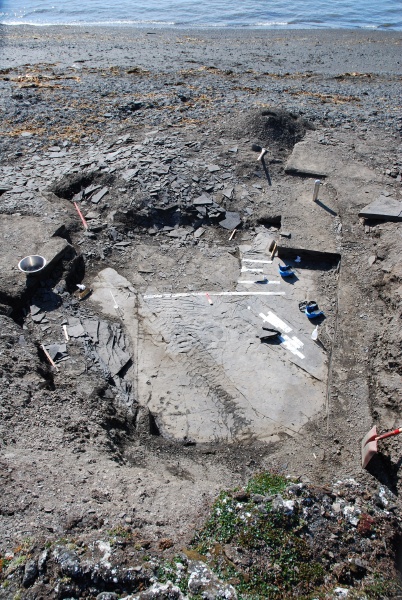A 240 million year-old Ichthyosauria specimen went on display at Tromsø University Museum in northern Norway. The Botneheia ichthyosaur, presumably a new species, was the largest predator of its day.
A team from the University of Tromsø, the Norwegian Polar Institute, and the University of Tübingen discovered the exceptionally large specimen at Svalbard, Norway. The preparation and exhibition of the fossil was sponsored by the Norwegian oil company StatoilHydro.
What species is it?
The fossil from the Botneheia Formation at Sauriedalen, Svalbard belongs to the Ichthyosauria (meaning ”fish-lizards”), a large group of marine reptiles that roamed the oceans for most of the Mesozoic. It is among the more “primitive” and early ichthyosaurs of the Triassic that the new find from Svalbard finds its place.
As no large ichthyosaurs have so far been described from the Middle Triassic of Svalbard, there is a high probability that one is dealing with a genus and species new to science.

How long was it?
The fossil is preserved in articulated state and reaches a length of approximately 6 metres. However, the head and the tip of the tail are missing due to erosion. If we assume that the size of the skull relative to the rest of the body was similar to other known large Triassic forms, it is conceivable that the specimen, if complete, would have been about 10 m long at minimum and more than 12 m long at maximum. This is an exceptionally large specimen compared with earlier finds.
What did it eat?
The Botneheia Formation contains a fauna of invertebrates rich in individuals but poor in genera and species. Only one genus of bivalve is very common: Daonella sp. One also finds a rich fauna of ammonoids and rare nautiloids. Several ammonoid specimens were found in close association with the ichthyosaur, and also in the rock layers below and above it. Fish are, contrasting to the ammonoids, almost absent. Except for a single jaw, no remains of fish were found during the excavation.
The question therefore arises: what did the Botneheia ichthyosaur, probably the largest predator in its time and place, actually eat?
It is assumed that it had, like the majority of large ichthyosaurs known, a typical carnivore’s dentition and was feeding on fish, soft-bodied cephalopods and other, smaller marine reptiles. A find of one of its Lower Triassic relatives has been made on Svalbard which supports the idea of a cephalopod diet. In its stomach numerous cephalopod hooklets have been found.
How did ichthyosaurs reproduce?
We know a lot about how ichthyosaurs reproduce due to the extraordinary findings of pregnant ichthyosaur mothers with the skeletons of the embryos still preserved in the body cavity, discovered since the 18th century at the famous Jurassic Holzmaden locality in Germany.
These findings demonstrate that, like mammals, ichthyosaurs gave birth to living young. Therefore we can safely assume that our Botneheia ichthyosaur did not hatch from an egg. Instead, it started its life as a small baby ichthyosaur born directly into the ocean by its mother.
How did it die?
Even though the Botneheia ichthyosaur grew to an enormous size, being the most formidable predator in its environment, it eventually died. From what reason will probably remain a mystery forever. We can exclude, nevertheless, the possibility that it fell victim to another predator. What we have of the skeleton is virtually complete and largely undisturbed. Nobody bit it, nobody even fed on its carcass. And who in the Botneheia Ocean should have attacked this huge animal? The ichthyosaur probably died unspectacularly from old age or disease.
At any rate its carcass sank to the bottom of the sea and was covered by sediment relatively fast. After the skeleton had been completely embedded it was only a matter of time – much time – until the stinky black mud around it consolidated and became the shales of the Botneheia Formation, containing the remains of ammonoids, Daonella bivalves and a large ichthyosaur.
How did it swim? Was it fast or slow?
It is always difficult to estimate the speed of an extinct animal. In ichthyosaurs, at least in some species, we know a little more than in most other extinct vertebrates. Our Botneheia ichthyosaur did not have the sophisticated tailfin of its fast swimming Jurassic relatives, nor did it have their torpedo-shaped super-streamlined body. Instead, it was a rather elongated, more snake-like animal with a very long, almost straight and rather crocodile-like tail.
It is highly likely that this animal rather swam like a gigantic eel, with undulatory lateral movements of most of its body and particularly its very long and laterally flattened tail. The posterior portion of the tail was slightly deflected downwards, creating additional lift during swimming. The four large flippers that the Botneheia ichthyosaur had were use in steering and manoeuvring. It was therefore certainly not as fast as its Jurassic relatives, but a capable and good swimmer nonetheless.
The fossil joined a full scale model of an iguanodon, nick-named IGU, and was also given its nickname following a national name competition among Norwegian children.
Facts:
•Discovered in 2001 in Sauriedalen, Svalbard, Norway
•Uncovered 2006 – 2007 by scientists from Tromsø University Museum, Norwegian Polar Institute and University of Tübingen, Germany
•Found in a sandstone deposit from the Triassic, 240 million years old
•About 6 meters preserved of the fossil
•Having an original length of minimum 10 metres and maximum 12 metres, this is an exceptionally large specimen
•The largest predator in its time and place
•A genus and species new to science?
•A diet of soft-bodied cephalopods, fish, and smaller marine reptiles
•Ichthyosaurs gave birth to living young
•The ichthyosaur probably died unspectacularly from old age or disease
•Preparation at Tromsø University Museum, Norway, sponsored by StatoliHydro
•The ichthyosaur will be permanently exhibited at Tromsø University Museum, Northern Norway
•The ichthyosaur will on 5th of April be given a nickname following a national name competition among Norwegian children




Comments